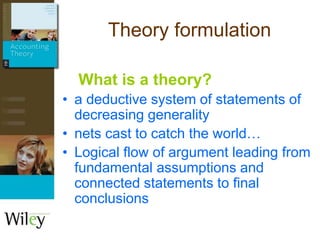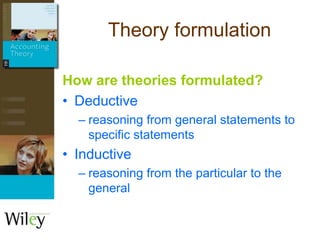Ch.02_Theory and Method.ppt
- 1. Prepared by Arabella Volkov University of Southern Queensland
- 2. References âĒ Text â Chapter 2 Theory and Method
- 3. Learning Objectives At the conclusion of this lecture, you should have an appreciation of: â why there are different types of theories of accounting â the difference between deductive and inductive approaches to theory development â the importance of syntax, semantics and pragmatism in developing and evaluating theories
- 4. Learning Objectives At the conclusion of this lecture, you should have an appreciation of: âĒ the difference between dogmatic, self-evident and scientific tests of the âtruthfulnessâ of theories âĒ how scientific theories are developed and tested and how they progress
- 5. Imposing order Accountants often need to impose some sort of order on imprecise events and transactions âĒ Exercise appropriate judgement â Analyse the financial implications of transactions â Assess the impact of transactions â Establish the legal entitlement â Calculate the current value
- 6. A range of accounting theories Accounting as: âĒ a historical record âĒ a language âĒ intracorporate politics âĒ standards setting as politics
- 7. A range of accounting theories Accounting as: âĒ mythology âĒ magic âĒ communication-decision information âĒ an economic good âĒ a social commodity
- 8. A range of accounting theories Accounting as: âĒ ideology and exploitation âĒ a social club
- 9. Theory formulation What is a theory? âĒ a deductive system of statements of decreasing generality âĒ nets cast to catch the worldâĶ âĒ Logical flow of argument leading from fundamental assumptions and connected statements to final conclusions
- 10. Theory formulation How are theories formulated? âĒ Deductive â reasoning from general statements to specific statements âĒ Inductive â reasoning from the particular to the general
- 11. Theory formulation Formulating a theory âĒ Epistemology â the study of the acquisition of knowledge âĒ Accounting theorists have drawn on the natural sciences âĒ Accounting: â Social science â Measurement and technical process âĒ Scientific or naturalistic method?
- 12. Parts of a theory Syntactics: âĒ Rules of the language used âĒ Syllogism: set of premises and conclusion Premise 1: All accounts relating to assets have debit balances. Premise 2: The accumulated depreciation account relates to assets. Conclusion: The accumulated depreciation account has a debit balance.
- 13. Parts of a theory Semantics: âĒ Links the basic concepts of a theory to objects in the real world Premise 1: All asset accounts have debit balances. Premise 2: The sales returns account is not an asset account. Conclusion: The sales returns account has a debit balance.
- 14. Parts of a theory Pragmatics: âĒ The effect of words or symbols on people Accounting should provide useful information for decision making to certain interested parties
- 15. Testing a Theory Criteria of truth: âĒ Dogmatic basis â âbelieve what we readâ âĒ Self-evident basis â reasonableness âĒ Scientific basis â Syntactics and induction
- 16. Testing a Theory 1. Identify research problem 2. Develop theoretical framework 3. State hypothesis 4. Construct research design 5. Observe 6. Analyse 7. Evaluate 8. Assess limitations and constraints Theory plane Observation plane Empirical Accounting Research Program
- 17. Testing a Theory Criteria of truth âĒ Scientific basis âPopper and falsification âResearch programs âKuhnian paradigms or disciplinary matrices âFeyerabendâs approach
- 18. Summary âĒ A number of conflicting theories have developed âĒ A theory generally consists of three parts âĒ There are several criteria for judging a theory âĒ Persuasiveness of evidence
- 19. Key terms and concepts âĒ Theory âĒ Natural science or Social science âĒ Deductive âĒ Inductive âĒ Syntax âĒ Semantics âĒ Pragmatism
- 20. Where to get more information âĒ Other courses âĒ List books âĒ Articles âĒ Electronic sources




















